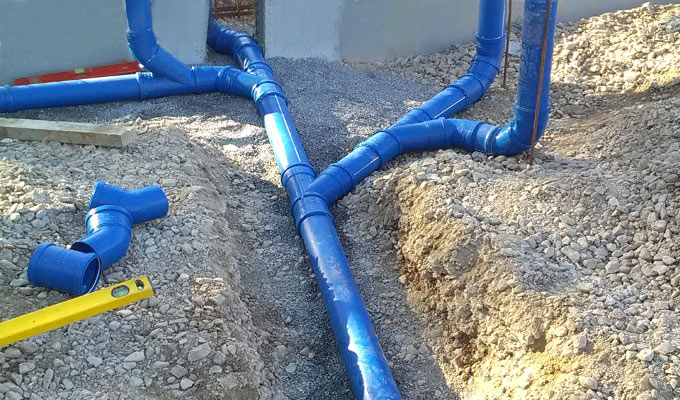

Evacuation of Waters from outside
For drainage outside buildings, you need to choose reinforced pipes that can withstand the weight of the soil and/or the natural settling of the ground. Another essential point is the connection of the pipes. To limit the risk of breakage, ATE recommends the use of joints, which guarantee a high level of watertightness and allow the pipes to move with the ground. A solution to be preferred to gluing. A strong, continuous pipe network is vital to the quality of a home’s rainwater and wastewater drainage.
HOW SEWAGE SYSTEMS WORK
External sanitation covers all sanitation installations, both for rainwater drainage and for the disposal of wastewater generated by the home. This domestic wastewater falls into two categories: black water from toilets and so-called household water, which includes water from cooking, showering, cleaning, etc. This water must be collected and then sent to the public network for treatment in a dedicated structure such as a wastewater treatment plant.
Local health regulations specify the conditions and obligations of residents in terms of collecting and disposing of rainwater. Generally speaking, the owner of a house is responsible for collecting rainwater through a network of gutters from the roof to a manhole. A rainwater drainage system is installed in this collection “box”. Depending on the municipality, the rainwater is then channelled into the collective network or treated directly on the plot.
CHOOSE PIPES DESIGNED FOR OUTDOOR USE
Transporting wastewater to the public sewerage system can involve laying from 5 to over 50 metres of pipe. The same applies to connecting rainwater to the public network or to an individual treatment facility located on the plot, away from the buildings. For both rainwater and wastewater drainage, the choice of the type of pipes used to convey the water is essential.
As the pipe network is buried, it is essential to opt for pipes specially designed for outdoor use. These pipes are not fire-resistant like internal pipes (NF Me standard), which are designed to slow the progress of flames. However, they are designed to withstand the weight of soil from a depth of 40 centimetres to 8 metres. They are characterised by their mechanical resistance to constant crushing. Rated SN4 or SN8 according to their level of mechanical resistance, these reinforced pipes are extremely durable.
PIPE JOINTS: USE JOINTS RATHER THAN ADHESIVES
To ensure optimum drainage of buildings from the outside, and to ensure the durability of your sewerage system, you need to choose reinforced pipes. The other point not to be overlooked is the junction between the different pipes. Pipes are sometimes connected by gluing. However, temperatures below 5 degrees and rain can jeopardise the bond. The glue creates rigidity, which can cause the network to break as a result of natural ground movements.
To avoid the pitfalls of the gluing technique, ATE has developed a diameter 100 joint connection system (pipes and fittings). With this principle, gluing is no longer necessary, simply using the Sancol diameter 100 range, where the joint is already integrated into the groove of the pipe or fitting. Unlike glue, which makes the pipes stiff at the connection point, the thickness of the gasket absorbs ground movements and ensures the installation is watertight.